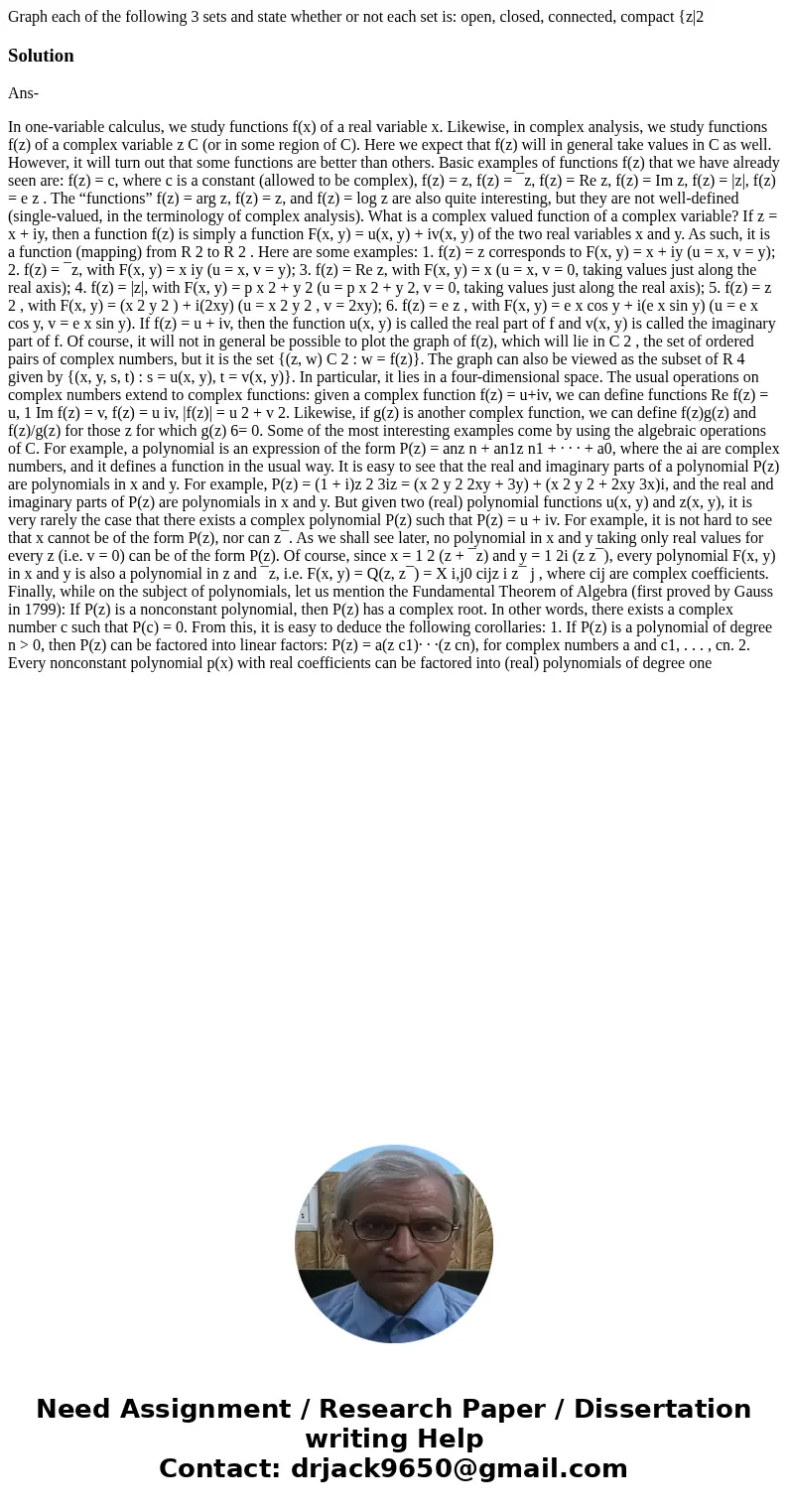Graph each of the following 3 sets and state whether or not
Solution
Ans-
In one-variable calculus, we study functions f(x) of a real variable x. Likewise, in complex analysis, we study functions f(z) of a complex variable z C (or in some region of C). Here we expect that f(z) will in general take values in C as well. However, it will turn out that some functions are better than others. Basic examples of functions f(z) that we have already seen are: f(z) = c, where c is a constant (allowed to be complex), f(z) = z, f(z) = ¯z, f(z) = Re z, f(z) = Im z, f(z) = |z|, f(z) = e z . The “functions” f(z) = arg z, f(z) = z, and f(z) = log z are also quite interesting, but they are not well-defined (single-valued, in the terminology of complex analysis). What is a complex valued function of a complex variable? If z = x + iy, then a function f(z) is simply a function F(x, y) = u(x, y) + iv(x, y) of the two real variables x and y. As such, it is a function (mapping) from R 2 to R 2 . Here are some examples: 1. f(z) = z corresponds to F(x, y) = x + iy (u = x, v = y); 2. f(z) = ¯z, with F(x, y) = x iy (u = x, v = y); 3. f(z) = Re z, with F(x, y) = x (u = x, v = 0, taking values just along the real axis); 4. f(z) = |z|, with F(x, y) = p x 2 + y 2 (u = p x 2 + y 2, v = 0, taking values just along the real axis); 5. f(z) = z 2 , with F(x, y) = (x 2 y 2 ) + i(2xy) (u = x 2 y 2 , v = 2xy); 6. f(z) = e z , with F(x, y) = e x cos y + i(e x sin y) (u = e x cos y, v = e x sin y). If f(z) = u + iv, then the function u(x, y) is called the real part of f and v(x, y) is called the imaginary part of f. Of course, it will not in general be possible to plot the graph of f(z), which will lie in C 2 , the set of ordered pairs of complex numbers, but it is the set {(z, w) C 2 : w = f(z)}. The graph can also be viewed as the subset of R 4 given by {(x, y, s, t) : s = u(x, y), t = v(x, y)}. In particular, it lies in a four-dimensional space. The usual operations on complex numbers extend to complex functions: given a complex function f(z) = u+iv, we can define functions Re f(z) = u, 1 Im f(z) = v, f(z) = u iv, |f(z)| = u 2 + v 2. Likewise, if g(z) is another complex function, we can define f(z)g(z) and f(z)/g(z) for those z for which g(z) 6= 0. Some of the most interesting examples come by using the algebraic operations of C. For example, a polynomial is an expression of the form P(z) = anz n + an1z n1 + · · · + a0, where the ai are complex numbers, and it defines a function in the usual way. It is easy to see that the real and imaginary parts of a polynomial P(z) are polynomials in x and y. For example, P(z) = (1 + i)z 2 3iz = (x 2 y 2 2xy + 3y) + (x 2 y 2 + 2xy 3x)i, and the real and imaginary parts of P(z) are polynomials in x and y. But given two (real) polynomial functions u(x, y) and z(x, y), it is very rarely the case that there exists a complex polynomial P(z) such that P(z) = u + iv. For example, it is not hard to see that x cannot be of the form P(z), nor can z¯. As we shall see later, no polynomial in x and y taking only real values for every z (i.e. v = 0) can be of the form P(z). Of course, since x = 1 2 (z + ¯z) and y = 1 2i (z z¯), every polynomial F(x, y) in x and y is also a polynomial in z and ¯z, i.e. F(x, y) = Q(z, z¯) = X i,j0 cijz i z¯ j , where cij are complex coefficients. Finally, while on the subject of polynomials, let us mention the Fundamental Theorem of Algebra (first proved by Gauss in 1799): If P(z) is a nonconstant polynomial, then P(z) has a complex root. In other words, there exists a complex number c such that P(c) = 0. From this, it is easy to deduce the following corollaries: 1. If P(z) is a polynomial of degree n > 0, then P(z) can be factored into linear factors: P(z) = a(z c1)· · ·(z cn), for complex numbers a and c1, . . . , cn. 2. Every nonconstant polynomial p(x) with real coefficients can be factored into (real) polynomials of degree one

 Homework Sourse
Homework Sourse